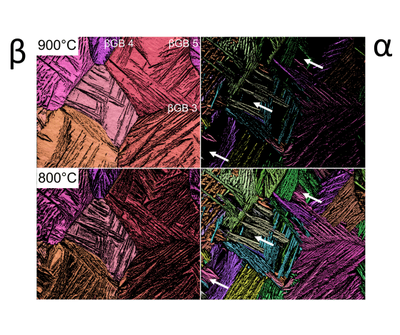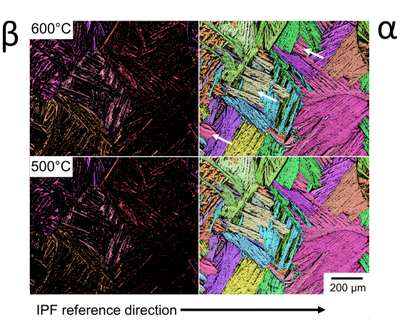


In-situ cooling experiments on Ti64
Most of the knowledge regarding the β → α + β phase transformation in Ti-6Al-4V (Ti64) is from post-mortem observation or studies of β-stabilised analogues. Here, for the first time on Ti64, in-situ cooling experiments have been performed, with a high temperature SEM heating stage, using sequential electron backscatter diffraction mapping and live secondary electron video recording. These techniques allowed development of grain boundary (GB) α colony microstructures to be observed directly while cooling at low rates (0.3 – 0.1°C s−1) through the β transus. It was discovered that the α colonies develop discontinuously, where sparse ‘primary’ lamellae appear first at the β GBs with low undercoolings, and rapidly advance into the grains until impingement. These initial laths develop into a ‘skeletal template’ for the following nucleating lamellae by fixing the variant in their domain of influence, as the phase transformation continues. This is due to biasing of the autocatalytic nucleation of the secondary lamellae among plate broadening and branching to fill in the remaining β matrix. This is in agreement with previous investigations of the crystallographic relationships between the α allotriomorphs and colonies that nucleate, and the β GBs. Although, an allotriomorph was not always required for the nucleation of a single variant α colony (when observed at a surface at least), and the primary laths often nucleated directly from a β GB simultaneously with the allotriomorph.
Davis, A. E., Donoghue, J., Kennedy, J. R., Byres, N., & Prangnell, P. B. (2021). In-situ observation of single variant α colony formation in Ti-6Al-4V. Acta Materialia, 220. https://doi.org/10.1016/j.actamat.2021.117315
Information
- Research Area:Material Development
-
Investigators:
Phil Prangnell
, Alec Davis - Publications:https://doi.org/10.1016/j.actamat.2021.117315
